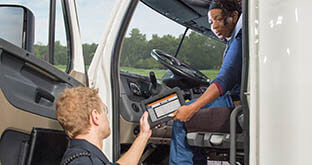Sr. Transportation Management Editor — J. J. Keller & Associates, Inc.
10 Tips for a Successful ELD Roadside Inspection
Make sure drivers have the safeguards in place to pass a roadside inspection at any time.
Published On: 10/01/2024
This article was originally published in 2019, and updated in 2024.


Written by:
Mark Schedler
Preparing your drivers and dispatch team for successful roadside inspections doesn’t just help minimize the chance of vehicle-related violations — it’s critical for avoiding accidents and minimizing over-the-road repairs. Improve compliance and safety across your fleet with these 10 tips for a successful ELD roadside inspection.
1. Clean the Truck Cab
Pay attention to the overall cleanliness of the cab. Remove extra garbage, especially from the top of the dashboard, which could impact viability and potentially cause items to drop into the area of the brake and accelerator pedals. A messy cab makes the officer ask “What else isn’t in order with this driver or vehicle?”
2. Plan Your Route
The benefits of planning every single trip in advance are three-fold:
- Compliance: Make sure you have enough hours available and opportunities to take required breaks so you can legally and safely reach your destination without becoming fatigued.
- Safety: Check the weather forecast and plan your route so you can avoid excessive delays driving through big cities and extending the workday.
- Effectiveness: Look for potential obstacles along the route such as road closures, construction, or tolls that may cause delays. If applicable, use only route-planning software/applications suitable for use with heavy-duty truck operations to avoid illegal routes, low overpasses, and other hazards.
3. Conduct a Thorough Pre-Trip Inspection
While each company’s version of a “proper” pre-trip inspection may differ slightly, as a standard, required items should be checked in the same sequence each time to create the habit for conducting a thorough pre-trip. There is no industry standard amount of time to log for a pretrip. Thorough inspections should be completed and logged for the actual time taken to do so.
4. Mount, Charge, Connect, and Update HOS Electronic Logging Devices Before Driving
Before operating the vehicle, verify that the ELD display is in a fixed position where you (the driver) can view the device when seated driving position. Drivers must be able to present their record of duty status to an inspection officer via wireless web services and email, or USB and Bluetooth. For this reason, dDrivers should take extra caution to ensure their hours-of-service devices are fully charged and operating as expected, along with being updated to the most recent actual duty-status change.
Any unassigned driving time must have been accepted if legitimate, or rejected for processing by the office staff before commencing driving for the day.
Personal conveyance (PC) events must not have any business purpose and the driver must have been released from all duties. A PC event such as a move to a maintenance shop or closer to a shipper, will be reclassified as on-duty driving time during an inspection and a violation will likely be received. Misuse of PC is a major reason that falsification is usually in the top five driver roadside violations.
5. Know Hours-of-Service Limits and Rules of Exception(s) Used
Make sure drivers and officer dispatch personnel know the hours of service rules and understand how many consecutive hours drivers are allowed to drive before they are required to take a break, if drivers qualify for any exceptions, and how to make appropriate use of their ELD to help regulate their compliance.
6. Ensure Truck Driver In-Cab Driving Paperwork is in Order
Drivers should keep all applicable documentation up to date, organized, and easily accessible from their cab. Required documents include:
- Driver’s license, medical certification, and any applicable medical waivers
- Supporting documents, such as bills of lading and expense reports (up to eight supporting documents need to be retained for each driver, each day)
- Hazmat documentation
- Annual vehicle inspection information
- Permit credentials, including the International Registration Plan (IRP) cab card, International Fuel Tax Agreement (IFTA) license and decals, and any temporary permit
- ELD-related documents, including eight days of blank logs, driver information, and malfunction/transfer instructions for the device being used
7. Confirm Prior Days’ Record of Duty Status’ (RODS) Certified on the ELD
Prior days’ RODS must be certified immediately after the last change of duty status for the applicable 24-hour period. Leaving logs uncertified is the same as having a prior day paper log that isn’t signed — it’s a violation.
8. Conduct a Thorough Post-Trip Inspection
Post-trip inspections should include the same vehicle components checked in the pre-trip inspection. Establish a consistent step-by-step process for completing the inspection in an efficient manner, without leaving anything out.
9. Complete DVIR to Note Any Safety Defects
Drivers of property- and passenger-carrying vehicles should complete a driver vehicle inspection report when a defect exists that affects the safety of the vehicle or could cause a potential breakdown. Carriers may require a DVIR regardless of the presence of defects.
10. Be Positive
Attitude is everything. Drivers should remain calm, be respectful, avoid argument, and ask the officer to explain the violation(s). A driver can’t talk themselves out of an inspection, but they can certainly talk the officer into one.
Drivers and motor carriers share equal responsibility for achieving violation-free roadside inspections. Drivers should be prepared for a roadside inspection at any time, while it is the ongoing responsibility of the carrier to keep drivers trained, well informed of regulatory changes, and positioned for success. For additional roadside inspection tips, request your FREE copy of the Roadside Inspection eBook.
You may also enjoy the following articles:
Sign up for our newsletter!
We'll help you stay on top of regulations, best practices, and fleet industry news. Sign up to receive a monthly email notification with links to our most recent blog articles, free resources, and event invites.
